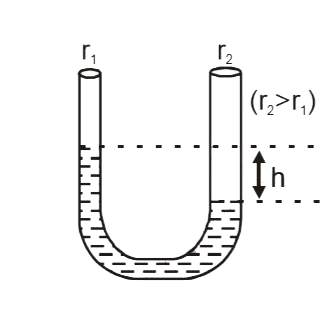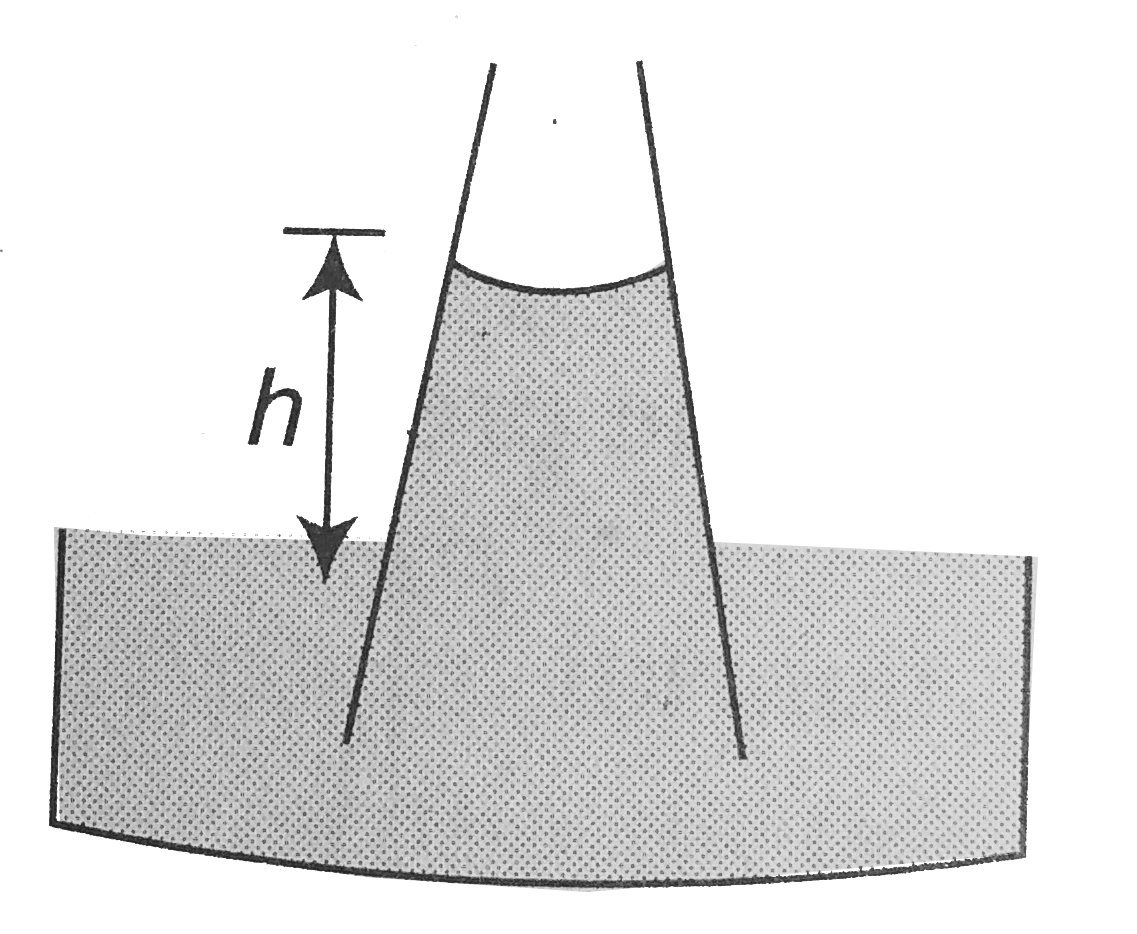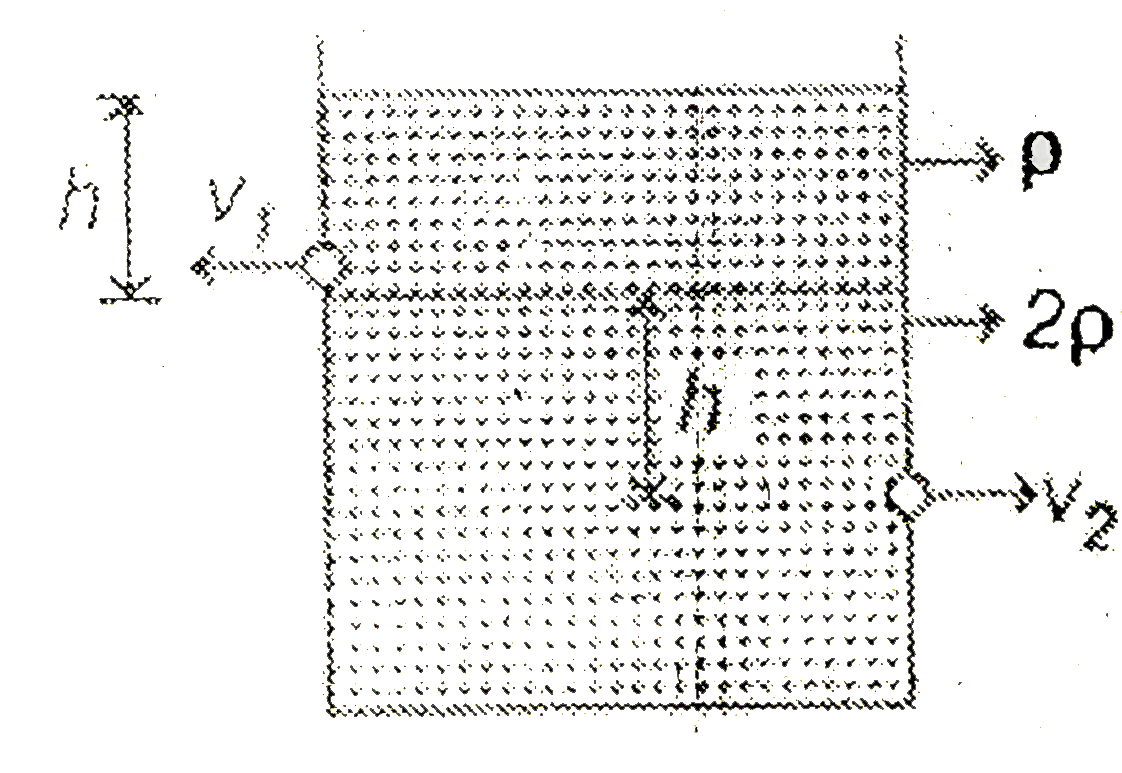The radii of the two columne is U-tube are r1 and r2(>r1). When a liquid of density ρ (angle of contact is 0∘)) is filled in it, the level different of liquid in two arms is h. The surface tension of liquid is
(g= acceleration due to gravity)
ρghr1r22(r2−r1)
ρgh(r2−r1)2r1r2
2(r2−r1)ρghr1r2
ρgh2(r2−r1)
The correct Answer is:A
To solve the problem, we need to analyze the U-tube with two different radii and the liquid filled in it. Here’s a step-by-step solution:
Step 1: Understand the Setup
We have a U-tube with two arms. The radius of one arm is r1 and the radius of the other arm is r2 (where r2>r1). The liquid has a density ρ and the angle of contact is 0∘. The height difference between the two arms is h.
Step 2: Pressure at Points A, B, and C
Let’s denote:
- PA: Pressure at point A (atmospheric pressure, P0)
- PB: Pressure at point B (in the arm with radius r2)
- PC: Pressure at point C (in the arm with radius r1)
Since the liquid is in equilibrium, we can express the pressures at points B and C in terms of surface tension T.
Step 3: Express Pressures Using Surface Tension
For point B (in the arm with radius r2):
PB=P0−2Tr2
For point C (in the arm with radius r1):
PC=P0−2Tr1
Step 4: Relate Pressures Using Height Difference
The pressure difference between points B and C can be expressed in terms of the height difference h:
PB−PC=ρgh
Step 5: Substitute Pressures into the Equation
Substituting the expressions for PB and PC into the pressure difference equation:
(P0−2Tr2)−(P0−2Tr1)=ρgh
Step 6: Simplify the Equation
The P0 terms cancel out:
−2Tr2+2Tr1=ρgh
Rearranging gives:
2Tr1−2Tr2=ρgh
Step 7: Factor Out Surface Tension
Factoring out 2T:
2T(1r1−1r2)=ρgh
Step 8: Solve for Surface Tension T
Now, we can solve for T:
T=ρgh2(1r1−1r2)
This can be rewritten as:
T=ρgh⋅r1r22(r2−r1)
Final Answer
Thus, the surface tension T of the liquid is given by:
T=ρgh⋅r1r22(r2−r1)
---
We have a U-tube with two arms. The radius of one arm is r1 and the radius of the other arm is r2 (where r2>r1). The liquid has a density ρ and the angle of contact is 0∘. The height difference between the two arms is h.
Let’s denote:
- PA: Pressure at point A (atmospheric pressure, P0)
- PB: Pressure at point B (in the arm with radius r2)
- PC: Pressure at point C (in the arm with radius r1)
For point B (in the arm with radius r2):
PB=P0−2Tr2
PC=P0−2Tr1
The pressure difference between points B and C can be expressed in terms of the height difference h:
PB−PC=ρgh
Substituting the expressions for PB and PC into the pressure difference equation:
(P0−2Tr2)−(P0−2Tr1)=ρgh
The P0 terms cancel out:
−2Tr2+2Tr1=ρgh
2Tr1−2Tr2=ρgh
Factoring out 2T:
2T(1r1−1r2)=ρgh
Now, we can solve for T:
T=ρgh2(1r1−1r2)
T=ρgh⋅r1r22(r2−r1)
Thus, the surface tension T of the liquid is given by:
T=ρgh⋅r1r22(r2−r1)
Topper's Solved these Questions
Similar Questions
The radii of the two columns is U-tube are r1 and r2(r2>r1). When a liquid of density ρ (angle of contact is 0∘)) is filled in it, the level different of liquid in two arms is h. The surface tension of liquid is
(g= acceleration due to gravity)View SolutionIn a U-tube the radii of two columns are respectively r1andr2 and if a liquid of density d filled in it has level difference of h then the surface tension of the liquid is -
 View Solution
View Solution
A capillary of the shape as shown is dipped in a liquid. Contact angle between the liquid and the capillary is 0∘ and effect of liquid inside the mexiscus is to be neglected. T is surface tension of the liquid, r is radius of the meniscus, g is acceleration due to gravity and ρ is density of the liquid then height h in equilibrium is:View SolutionA beaker containing a liquid of density ρ moves up with an acceleration a. The pressure due to the liquid at a depth h below the free surface of the liquid is.
View SolutionA capillary tube of radius r is lowered into a liquid of surface tension T and density ρ. Given angle of contact =0∘.
What is the potential energy acquired by the liquid in the capillary?View SolutionTwo holes are made at depths h and 2h from the top. A liquid of density ρ and height h is filled over another liquid of density 2ρ. Speeds of liquid ejecting from two holes are say v1 and v2.

If density of lower liquid is increasedView SolutionThe absolute pressure at a depth h below the surface of a liquid of density ρ is [Given Pa = atmospheric pressure, g = acceleration due to gravity]
View SolutionWhat is the height to which a liquid rises between two long parallel plates, a distance d apart ? (Surface tension of liquid is T and density is ρ)
View SolutionWhen a vertical capillary of length with the sealed upper end was brought in contact with the surface of a liquid, the level of this liquid rose to the height h. The liquid density is ρ, the inside diameter the capillary is d, the contact angle is θ, the atmospheric pressure is ρ0. Find the surface tension of the liquid. (Temperature this process remains constant.)
 View Solution
View SolutionWhen a vertical capillary of length l with a sealed upper end was brought in contact with the surface of a liquid, the level of this liquid rose to the height h. The liquid density is ρ, the inside diameter the capillary is d, the contact angle is θ, the atmospheric pressure is ρ0. Find the surface tension of the liquid. (Temperature in this process remains constant.)
 View Solution
View Solution

